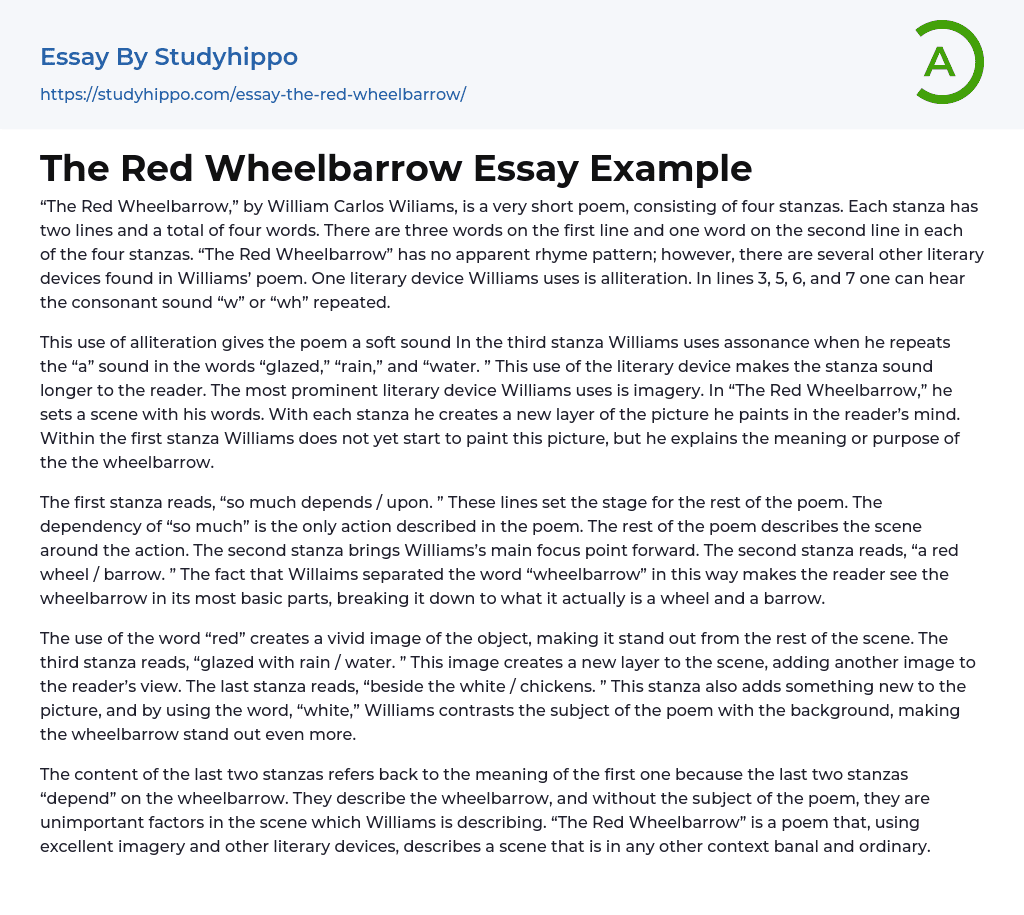“The Red Wheelbarrow,” by William Carlos Wiliams, is a very short poem, consisting of four stanzas. Each stanza has two lines and a total of four words. There are three words on the first line and one word on the second line in each of the four stanzas. “The Red Wheelbarrow” has no apparent rhyme pattern; however, there are several other literary devices found in Williams’ poem. One literary device Williams uses is alliteration. In lines 3, 5, 6, and 7 one can hear the consonant sound “w” or “wh” repeated.
This use of alliteration gives the poem a soft sound In the third stanza Williams uses assonance when he repeats the “a” sound in the words “glazed,” “rain,” and “water. ” This use of the literary device makes the stanza sou
...nd longer to the reader. The most prominent literary device Williams uses is imagery. In “The Red Wheelbarrow,” he sets a scene with his words. With each stanza he creates a new layer of the picture he paints in the reader’s mind. Within the first stanza Williams does not yet start to paint this picture, but he explains the meaning or purpose of the the wheelbarrow.
The first stanza reads, “so much depends / upon. ” These lines set the stage for the rest of the poem. The dependency of “so much” is the only action described in the poem. The rest of the poem describes the scene around the action. The second stanza brings Williams’s main focus point forward. The second stanza reads, “a red wheel / barrow. ” The fact that Willaims separated the word “wheelbarrow” in this
way makes the reader see the wheelbarrow in its most basic parts, breaking it down to what it actually is a wheel and a barrow.
The use of the word “red” creates a vivid image of the object, making it stand out from the rest of the scene. The third stanza reads, “glazed with rain / water. ” This image creates a new layer to the scene, adding another image to the reader’s view. The last stanza reads, “beside the white / chickens. ” This stanza also adds something new to the picture, and by using the word, “white,” Williams contrasts the subject of the poem with the background, making the wheelbarrow stand out even more.
The content of the last two stanzas refers back to the meaning of the first one because the last two stanzas “depend” on the wheelbarrow. They describe the wheelbarrow, and without the subject of the poem, they are unimportant factors in the scene which Williams is describing. “The Red Wheelbarrow” is a poem that, using excellent imagery and other literary devices, describes a scene that is in any other context banal and ordinary.
- Boo Radley essays
- Genesis essays
- Richard iii essays
- Alice in Wonderland essays
- On the road essays
- Ozymandias essays
- The Nightingale essays
- Holden Caulfield essays
- Animal Farm essays
- 1984 essays
- A Hanging essays
- Shooting An Elephant essays
- A Tale Of Two Cities essays
- Adventures Of Huckleberry Finn essays
- Arthur Conan Doyle essays
- Brave New World essays
- Characters In Hamlet essays
- Characters In Romeo And Juliet essays
- Desdemona essays
- Diary Of A Wimpy Kid essays
- First-Person Narrative essays
- Frankenstein essays
- Heart Of Darkness essays
- Jane Eyre essays
- Jay Gatsby essays
- King Duncan essays
- Librarian essays
- Little Red Riding Hood essays
- Lord Of The Flies essays
- Silas Marner essays
- The Cask Of Amontillado essays
- The Catcher In The Rye essays
- The Crucible essays
- The Handmaid's Tale essays
- The Reader essays
- Virgil essays
- Wuthering Heights essays
- Candide essays
- Castle essays
- J. D. Salinger essays
- Ulysses essays
- Ethan Frome essays
- In Cold Blood essays
- Outliers essays
- Tuesdays With Morrie essays
- The Art of War essays
- Wife of Bath essays
- Huckleberry Finn essays
- The Lady With The Dog essays
- Great Expectations essays




